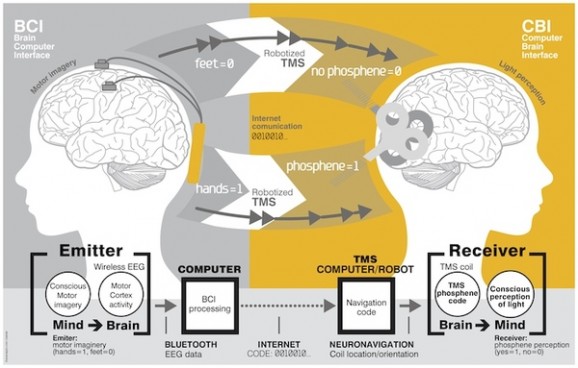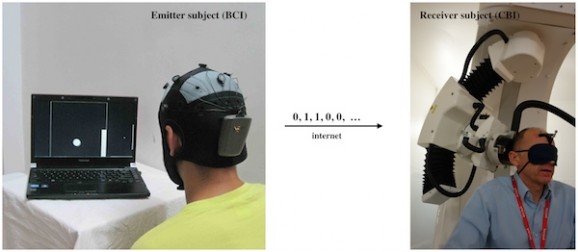Telepathic Communication Is Real (At Least Over The Internet)
This article is more than 2 years old
 Some claim that twins can communicate telepathically; so can a whole race of people from Babylon 5. I’ve given telepathy a try myself, usually by trying to guess the card a friend has drawn from the deck (and pressed to his forehead, just for good measure), but alas, I don’t seem to be able to communicate with others via thought alone. That doesn’t mean it’s impossible, though. A team of scientists recently published a study in PLoS ONE that demonstrates the feasibility of brain-to-brain
Some claim that twins can communicate telepathically; so can a whole race of people from Babylon 5. I’ve given telepathy a try myself, usually by trying to guess the card a friend has drawn from the deck (and pressed to his forehead, just for good measure), but alas, I don’t seem to be able to communicate with others via thought alone. That doesn’t mean it’s impossible, though. A team of scientists recently published a study in PLoS ONE that demonstrates the feasibility of brain-to-brain
communication.
The international team of scientists includes researchers from Harvard, Beth Israel Deaconess Medical Center, Spain’s Starlab Barcelona, and France’s Axilum Robotics. The team wanted to find out if it was possible for two people to communicate by taking one’s brain activity and essentially inserting it into the second person. The team then figured that the internet was probably the best way to transfer information, so they wanted to see if it was possible for two people to communicate via the internet without talking or typing.

The study participants weren’t conveying to one another complicated battle strategies, or even a grocery list, but they were able to communicate. For instance, one participant in India put on the good ol’ EEG (electroencephalography) cap, which has all those cool little electrodes that measure and record what the brain is up to. Simultaneously, three participants in France got wired into a transcranial magnetic stimulation (TMS) device and donned a blindfold. Both subjects were connected to the Internet (of course).
The participant in India then telepathically sent the binary translation for “hola” and “ciao” to the subjects in France. How exactly did he do this? Apparently, if he imagined moving his hands, a “1” was sent to the other object, and if he imagined moving his feet, a “0” was sent. The subject in France saw these communications as light — if the light was in a certain location, that indicated a 1, and if it was in a different location, that indicated a 0. It took a while, but in this way the subject in India sent the words over and the subjects in France received them, after which they were converted into words. The first time around, the error rate was 11%, but after that, it dropped to 4%, indicating that practice makes almost perfect when it comes to brain-brain communication.
While this isn’t the first successful brain-to-brain experiment (see video below), it is the first time actual information has been conveyed this way. It’s not hard to imagine the applicability of an approach like this — stroke patients and other people with conditions that render them unable to talk could convey information without having to press buttons or type. I’d love to be hooked up to Stephen Hawking, though I’m guessing I’d have to get in line behind all the physics students in the world. I’d also love to see a version for cats, which would be less intelligent but probably much more entertaining.












